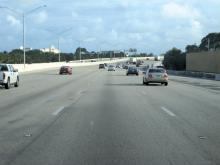In the US, state DOTs are preparing for the upcoming reauthorisation battle in a tough economic and political climate. Set to expire by the end of the year, the bill is a critical funding source for many transportation projects in the US. However transportation officials in the US are facing a tough battle as the political and economic climate has changed considerably since the last reauthorisation was passed, shortly after President Obama's inauguration in January 2009. Since then, the recession has contin

The US interstate network requires further investment for all the necessary projects to be carried out
US state DOTs are facing an uphill reauthorisation battle writes Andrew Bardin Williams
In the US, state DOTs are preparing for the upcoming reauthorisation battle in a tough economic and political climate. Set to expire by the end of the year, the bill is a critical funding source for many transportation projects in the US. However transportation officials in the US are facing a tough battle as the political and economic climate has changed considerably since the last reauthorisation was passed, shortly after President Obama's inauguration in January 2009. Since then, the recession has continued to shed jobs, the deficit has exploded and the US public is growing increasingly cynical about any government spending.A panel discussion among representatives of transportation associations was held recently at the
The need for a bill is certainly there. Pressure from environmentalists, private enterprise and concerned safety-conscience citizens is driving home the need for long-term infrastructure investments from mass transit to highway and bridge improvements to updating trucking and shipping infrastructures. And then there are the millions of jobs reliant on a robust transportation industry, many of which have dried up in the economic crisis.
According to Brian Deery, a senior director for the Associated General Contractors of America (AGC), the highway construction industry is still facing 15% unemployment, and that number is set to skyrocket once the federal stimulus funding begins to run dry. Transit workers and truck drivers are in the same boat. One way to save those jobs, according to Deery, is to make sure the reauthorisation bill is passed this year and long-term infrastructure investment is made.
However, given the dire situation in Washington and an uncertain mid-term election in November, there is little political will to get a bill completed and passed by the midnight New Year's Eve expiration date. States are going to have to look at other funding sources if they want to ensure funding for on-going and future transportation projects. In short, reauthorisation is only part of the funding puzzle.
"You can't run all surface transportation out of Washington, DC," said Hal Kassoff, a senior vice president for
One of those funding options is to raise the fuel tax. In fact, many of the panelists and those in the audience at WASHTO 2010 predict it will be raised, and a modest increase has the support of the transportation and shipping industries.The
Getting that funding though, is a tough proposition for state DOTs that are under the gun to reduce government and cut costs just to balance their budgets. With public confidence in government evaporating and the jobless rate remaining high, state DOTs face the prospect of pushing a transportation reauthorisation bill that continues to focus on short-term priorities instead of long-term infrastructure investment.
"State DOTs have the best understanding of what projects can be built, what won't get built and what that means for the public in terms of safety issues, congestion or long travel times," Millar said. "They need to relate that knowledge as clearly as they can so Congress and the public know what's important and what it would mean if reauthorisation doesn't happen." Finding funding for long-term projects as federal stimulus dollars begin to run out is likely to fall on public support for those projects. Luckily, voter referendums have been surprisingly successful in recent years. According to an APTA study, more than 70% of voter referendums that call for tax-payer funded transportation projects have passed in the past decade. One example is a 2005 referendum in Utah that raised the sales tax in two counties to pay for an expansion of Salt Lake City's light-rail system, one of the most conservative states in the country. "When voters understand the benefits of transportation projects they are much more likely to vote for tax increases," Millar said.
Kassoff from Parsons-Brinckerhoff agrees. "Understandably, people want to know what they're getting for their tax dollars, especially in this economic and political climate," he said.
Kassoff suggests that state DOTs should approach transportation funding as a political campaign, making sure they are working with the public and their local congressional delegation to educate them on the local transportation needs in their area and how those needs can be addressed through funding and reauthorisation. It is important that states know what they have already in place, what they need, how much it will cost, what the priorities of the tax payers are, who are the detractors and whether outside resources such as consultants, private enterprise and the public are available to help out.
Parsons-Brinckerhoff recently conducted a study of 11 transportation case studies and identified the messaging and tactics that worked. Those that were successful in highlighting the project as an investment for user benefits (such as faster drive times, less congestion, lower emissions) were most likely to be funded. In short, transportation funding needs to be connected to specific programs and problems.Washington State DOT understands that tax payers need to be behind funding initiatives or those projects are doomed to failure. Recognising that public perception is vital to garnering support, the state underwent a department-wide initiative to make its work (and the benefits it provides) more transparent to the state's citizens. WSDOT now publishes a performance management document on its Web site every two years called the Gray Notebook that outlines how transportation funding in the state is connected to the public and daily use of transit systems.
According to Paula Hammond, secretary of WSDOT, this effort begins and ends with reliable and accurate data collection. "Performance management and accountability goes beyond just checking a box or completing a report. It is about ensuring that citizens receive real results from their tax dollars and understand how these improvements to their highways or travel options improve their ability to get from home to work or enable businesses to thrive. Using real data to manage for best results as well as reporting progress can go a long way towards building public confidence in making further transportation investments," Hammond said.
As it relates to this year's reauthorisation effort, Hammond understands that her state's efforts to get a bill passed that they can live with is dependent on their ability to convince Congress of specific needs and her department's ability to prove they can deliver projects on time and under budget. That process is a lot easier with powerful performance management tools in place.
Some things her department has done is to standardise data collection at the local level, evaluate project success solely on accurate data and analysis, refocus the department's core mission around performance, measure "on time" and "on budget" separately, work data collection directly into project budgets and make sure information is readily available and easily accessible to everyone.
State DOTs are in for the fight of their lives if they hope to get a reauthorisation bill passed by the end of the year. They can help drive the process, however, by putting pressure on Congress through the public. Getting taxpayers behind important transportation projects is a simple matter of educating them about infrastructure needs and what the consequences are if those projects do not get funding. Using real-world results that show how infrastructure improvements affect each person is vital in getting those projects funded. If only politics were that easy.








